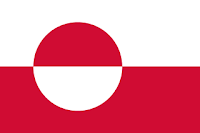Greenland (Greenlandic: Kalaallit
Nunaat, Danish: Grønland) is the world's largest island,
located between the Arctic and Atlantic oceans, east of the Canadian Arctic Archipelago.
It is an autonomous territory within
the Kingdom of Denmark. Though
physiographically a part
of the continent of North America, Greenland has been
politically and culturally associated with Europe (specifically Norway and Denmark, the colonial powers, as well as the nearby island of Iceland) for more than a millennium. The majority of its
residents are Inuit, whose ancestors migrated from Alaska through Northern Canada, gradually settling across the island by the
13th century.
Greenland is the world's
largest non-continental island and the third largest area in North America
after Canada and the United States. Greenland is bordered by the Arctic Ocean to the north, the Greenland Sea to the east, the North Atlantic Ocean to the southeast, the Davis Strait to the southwest, Baffin Bay to the west, the Nares Strait and Lincoln Sea to the northwest. The nearest countries are
Canada, to the west and southwest across Nares Strait and Baffin Bay; and
Iceland, southeast of Greenland in the Atlantic Ocean. Greenland also contains
the world's largest national park,
and it is the largest
dependent territory by
area in the world, as well as the fourth largest country subdivision in the world, after Sakha Republic in Russia, Australia's state of Western Australia, and Russia's Krasnoyarsk Krai, and the largest in North America.
Nowadays, the population
is largely concentrated on the southwest coast, while the rest of the island is
sparsely populated. Greenland is divided into five municipalities
— Sermersooq, Kujalleq, Qeqertalik, Qeqqata, and Avannaata. It has two unincorporated areas — the
Northeast Greenland National
Park and the Thule Air Base. The last
one, even if under Danish control, is administered by the United States Air Force.
Three-quarters of Greenland is covered by the only permanent ice sheet outside Antarctica. With a population of 56,081 (2020), it is the least densely populated territory in the world. About a third
of the population lives in Nuuk, the capital and largest city. The Arctic Umiaq Line ferry acts as a lifeline for western
Greenland, connecting the various cities and settlements.
In 1979,
Denmark granted home rule to Greenland; in 2008,
Greenlanders voted
in favor of the Self-Government Act, which transferred more power from the Danish government to the
local Greenlandic government. The capital, Nuuk,
held the 2016 Arctic Winter Games.
At 70%, Greenland has one of the highest shares of renewable energy in the
world, mostly coming from hydropower. The name of the country in the indigenous Greenlandic language is Kalaallit
Nunaat ("land of the Kalaallit"). The Kalaallit are the indigenous Greenlandic Inuit people
who inhabit the country's western region.
Stamps were issued by the Kongelige Grønlandske Handelin
in 1905 for use as parcel stamps. The stamps showed the coat
of arms of Greenland, featuring a standing polar bear. Letters were handled
free of charge by the Kongelige Grønlandske Handel until 1938. In 1938, postal
service was established and the first postage stamps of Greenland were issued
on 1 December. The series consisted of five stamps with a portrait of the
Danish king Christian X and two with the image of a polar
bear. In 1945, during the Second World War, a new
set of stamps was printed by the American Bank Note Company.
This series consisted of nine values, which in addition to King Christian X,
also showed seals, Inuit in a kayak, dog sleds and polar bears.
On March 11, 1969,
Greenland issued a stamp dedicated to the 70th birthday of King Frederick IX, which for
the first time the name of the country was inscribed in two languages, Danish and Greenlandic.
In 1922, in the town of Ivigtût (located in the southwestern part of Greenland, now
abandoned), a green stamp with the image of a polar bear and the inscription
“Ivigtut Kryolithbrud Bypost 1922" (Ivigtut Cryolite Mining Local mail 1922) was issued by the local
mining company providing mail delivery to the small town. Stamps were issued in
1935 for the remote settlement in Thule, in the northernmost area of Greenland, found by Knud Rasmussen. The series was issued on the 25th anniversary
of the founding of the settlement and depicted Knud Rasmussen, the Danish flag,
walruses and local scenery. The stamps were valid for mail from Thule to
Copenhagen.
This is my first Registered airmail from Greenland ! and one among the most expensive cover by postage rate. Greenland use Denmark postage tarif. The cover posted on February 02, 2016 and I received on February 20, 2016.
The covers posted from Tasiilaq on February 02, 2016 and I received on February 20, 2016.
The cover sent on September 04, 2013 and I received on September 14, 2013. Philately is one of the main income of Greenland, so they issue number of thematic stamps and other philatelic products every year.





No comments:
Post a Comment
Note: only a member of this blog may post a comment.